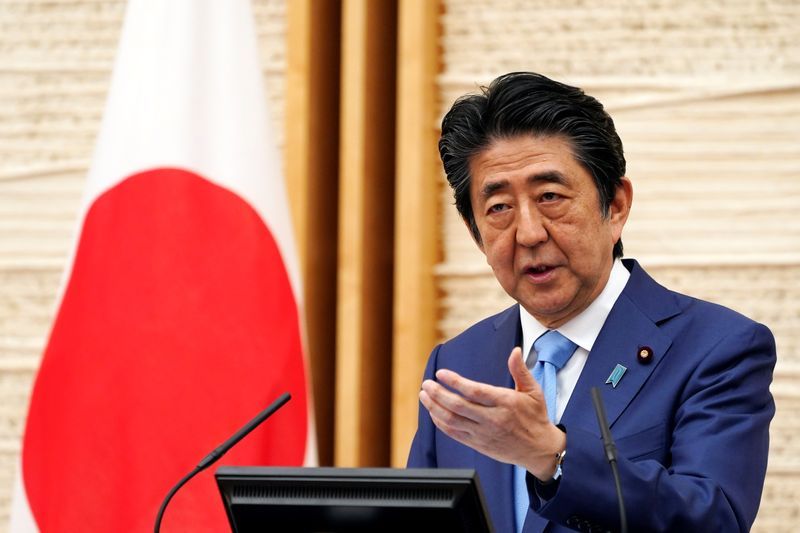The coronavirus or Covid-19 that broke out in the Chinese city of Wuhan in December 2019 and quickly spread to as many as 203 countries has infected as of 26 May 2020 over 5.59 million people with over 3.5 lakh fatalities (the number is rising), throwing the world leaders with a gigantic challenge how to combat this menace. While Europe has seen more fatalities with the US alone registering close to 1 lakh deaths compared to Asia, the challenge for the Asian countries is no less daunting.
The third and fourth biggest economies of the world, Japan and India, too are grappling with this challenge in their own ways. While India with a population of 1.378 billion has seen 4,172 deaths, Japan’s fatalities with a population of 126.2 million are 830. In this global challenge, how India and Japan are cooperating in fighting this virus? Both Prime Ministers Narendra Modi and Abe Shinzo spoke over phone and have worked out strategies suitable to their respective countries and sought common grounds to identify measures so that both can benefit from each other. The focus in this essay shall be mainly on Japan, evaluating measures adopted by Abe and results achieved.
After the virus broke out in Wuhan and started spreading outside of China, Japan took time in realising the severity of the virus, saying that was a China problem. But when it dawned that the virus is serious and the WHO declared it as a pandemic, Abe quickly stepped in to check its further spread.
Until around 10 April, Japan had unusually few confirmed cases of Covid-19, but government advisers warned that a recent spike could lead to a runaway spread that could overwhelm the health system. That exactly happened when the cases spiked suddenly by 16 April. Pre-empting this, Abe had declared a state of emergency on 7 April and announced a huge fiscal stimulus package worth a whopping 108.2 trillion yen ($993 billion), equal to 20 per cent of Japan’s economic output, to cushion the impact of the epidemic on the country’s economy.
In tackling with the issue, Abe faced critical choices: delicate balance between suppressing a resurgence of the virus and rekindling the faltering economy. Coming under severe criticism from the people for the manner of handling the issue, Abe decided on 14 May to lift the state of emergency in all but eight of the nation’s 47 prefectures, though emergency was first announced to remain in force till 31 May. Tokyo and seven prefectures are to maintain under emergency measures for some more time. The decision was prompted by the signs of progress in the decrease of new patients and expanding testing infrastructure. At the same time, peoples were warned that there could be a flare-up if restrictive measures are eased too abruptly.
Abe also cautioned the residents in prefectures where emergency was lifted to return to everyday life gradually, like avoiding non-urgent face-to-face meetings, embracing progressive changes in lifestyle like telecommuting, wearing masks and maintaining vigilance over the Covid-19. Truism, however, is even after lifting the state of emergency, the virus will continue to stay and therefore self-restricting norms are going to be the new normal. The same is going to be all over the world, even if a vaccine is made available.
Surprisingly, even when the number of fatalities surged to 830, Abe declared the end of the state of emergency ahead of schedule, removing curbs on economic activity in Tokyo and four other prefectures as experts judged the spread of infections was under control. With the removal of the restrictions, the recession-hit Japanese economy is expected to regain vigour, albeit at a gradual pace. The availability of medical resources, the capacity to provide virus tests and monitoring the spread of the virus promoted Abe to take the decision to lift the state of emergency. Abe weighed the need to keep new infections firmly under control against the urgent need to rejuvenate the economy.
Japanese people long used to use masks even in normal times quickly adapted to the new demand to alter their lifestyles of social distancing and working from home as experts warn against relaxing vigilance too soon amid the risk of another wave of infections as seen in China and South Korea. The government was determined to establish a transitional period and assess the infection situation every three weeks, requesting the people to stay at home and avoid large gathering.
On the enforcing of lockdown Japanese law does not give any enforcing authority to the authorities. The best that the state of emergency gave prefectural governors was legal authority to request people to forgo nonessential outings and businesses to suspend their operations.
Tokyo Governor Yuriko Koike, who earlier had argued for tough measures, unveiled a three-stage plan to relax restrictions, allowing restaurants and eateries to stay open longer until 10 PM, later than 8 PM as permitted under the emergency declaration, and schools to gradually resume classes. In the first phase, museums and libraries will open. In the second phase beginning by May-end, movie theatres and shops selling product other than daily necessities shall reopen. However, karaoke parlours, live music venues and gyms, places where the risk of group transmission is high, will be asked to remain closed. Though explosive surge of the virus has not occurred so far, infectious disease experts remind the public to remain alert for a second wave as restrictions are lifted.
Did Abe’s decision to life emergency have approval of the people? According to a survey by the Mainichi Shimbun on 23 May, 53 per cent of the respondents approved government’s move to lift the emergency for the entire country. Thirty-one percent of respondents said the moves came too soon, suggesting deep-rooted anxiety that the virus will begin to spread again. Six percent said the end of the state of emergency came too late. While a slim majority said they favoured lifting the emergency declaration, 59 per cent of respondents said they disapproved of how the administration of Abe had handled the crisis. Only 20 per cent of respondents said they approved of the government’s response.
In an earlier poll by the same newspaper and Social Survey Research Centre on 6 May, a majority of people across Japan agreed with the government’s decision to extend state of emergency measures till May-end. That time, 66 per cent of respondents indicated support by saying that the government’s decision was “valid,” while 25 per cent said that it “should have been limited to certain areas,” and just 3 per cent opted for “it shouldn’t have been extended.”
Even in an earlier survey made on 8 April by the same newspaper, a day after the declaration of emergency and announcement of economic stimulus package, 72 per cent of respondents gave a positive evaluation of Abe’s declaration of state of emergency for seven prefectures, while 21 per cent disapproved of the move. As per the 108 trillion-yen emergency stimulus package, the government planned to pay 300,000 yen to certain households whose income has dropped significantly as a result of the coronavirus outbreak.
Another crisis response measure that the government is mulling over is giving 200,000 yen ($1,900) for each medical worker at hospitals treating Covid-19 patients across Japan aimed at supporting doctors and nurses facing risk of infection while working on the frontline. The government fears a second wave of coronavirus cases to occur, and therefore hopes that the allowance will provide an incentive for medical institutions such as hospitals to continue accepting patients with COVID-19. The details of payment, such as eligibility and full amount are being worked out. Doctors dealing with Covid-19 have a genuine fear of risking infection. Workers at nursing homes are also likely to be eligible for the allowance.
The pandemic has forced Japanese people to make some significant lifestyle changes. The practice of exchanging business cards, for example, can be a health hazard and could be less popular. Japan might as well move towards electronic money. Where the Japanese have an edge over many overseas countries is the exemplary discipline they show in daily life. Both India and Japan can continue to exchange experience on addressing the pandemic. It shall be a new dimension added to a steady partnership.
(The Author is Lok Sabha Research Fellow, Parliament of India and Member, Governing Council of Indian Council of World Affairs, and Centre for Security and Strategic Studies, both in New Delhi. He was also Senior Fellow at IDSA and ICCR Chair Professor at Reitaku University, Japan. Views expressed are personal)
Image Source: https://s.yimg.com
(The views expressed are the author's own and do not necessarily reflect the position of the organisation)


